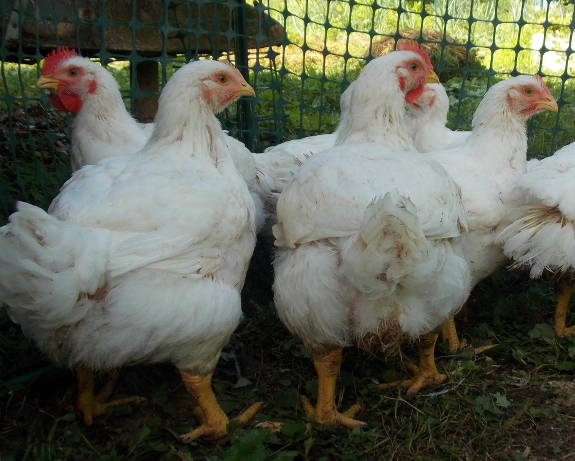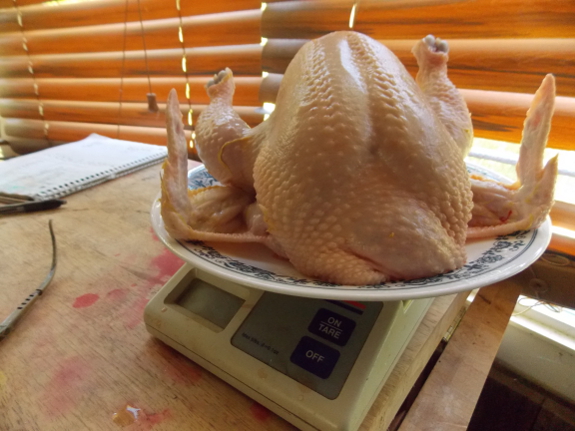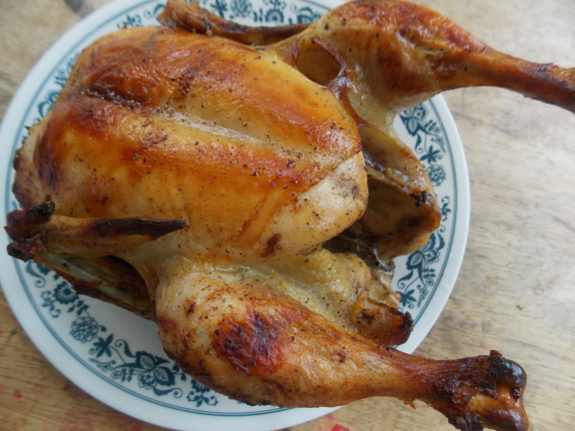
Cornish Cross taste test

Our Cornish Cross chickens
are clocking in at a dressed weight of around 3.9 pounds at six weeks
of age, which is the youngest you'd want to slaughter even these
ultra-speedy hybrids. We could expect our broilers to perhaps
double in size if we let them grow out another month, but, to be honest,
Mark and I are heartily sick of Cornish Cross and don't want to risk
dealing with the health problems that crop up as the birds get even
bigger. Since the six-week-old dressed weight of Cornish Cross is
already twice what we get out of twelve-week-old Australorps, we decided to slaughter at the youngest age possible and move on to birds we enjoy more.

As I butchered the
Cornish Cross carcasses, I could tell they were a very different bird
than we're used to, and not just because of their heavy weight, small
legs, and big breasts. With Australorps, I'm used to seeing
minimal fat, but what fat is present is richly yellow
due to their pastured diet. Despite the fact that our Cornish
Cross had access to just as much pasture as our other chickens do, their
fat was a very pale cream color, and there was much more fat
present. In retrospect, I think the only real way to get much
pasture at all into lazy Cornish Cross is to use Salatin-style chicken tractors,
and I'm sure even that would only result in a fraction of the
nutritional quality of the meat that we get out of our Australorps.

But what about flavor? I brined
and then roasted up a broiler twenty-four hours after slaughtering and
was pleasantly surprised to find that the taste of a homegrown bird is
superior to that of a supermarket chicken. On the other hand, the
Cornish Cross didn't hold a candle to the Australorp broilers we're
used to (although the former does have meat that's less tough than the
latter, due to the older age of our heirloom broilers).
In the end, we concluded
that Cornish Cross broilers are slightly cheaper to raise per pound than
Australorps are, have carcasses that are more familiar to the
mainstream American, and are ultra-speedy. But we're willing to
put in more time and a bit more money for healthier and tastier meat, so
we'll go back to our heirloom breed "at least for another ten years
until we forget what Cornish Cross are like," says Mark.
Want more in-depth information? Browse through our books.
Or explore more posts by date or by subject.
About us: Anna Hess and Mark Hamilton spent over a decade living self-sufficiently in the mountains of Virginia before moving north to start over from scratch in the foothills of Ohio. They've experimented with permaculture, no-till gardening, trailersteading, home-based microbusinesses and much more, writing about their adventures in both blogs and books.
Want to be notified when new comments are posted on this page? Click on the RSS button after you add a comment to subscribe to the comment feed, or simply check the box beside "email replies to me" while writing your comment.

Thanks for the comprehensive review of the Cornish! I've wondered how they compare to homegrown and store-bought birds. On another note, not long ago you pondered which gender of chicks it is that engages in the chest-bumping semi-aggression...I have some probably-pure-bred Creme Legbars, which can be sexed by color from day one. It looks like the males and females both engage in this behavior (age at start was about 3 weeks), but the males are much more into it than are the females, at least for this brood/this breed.